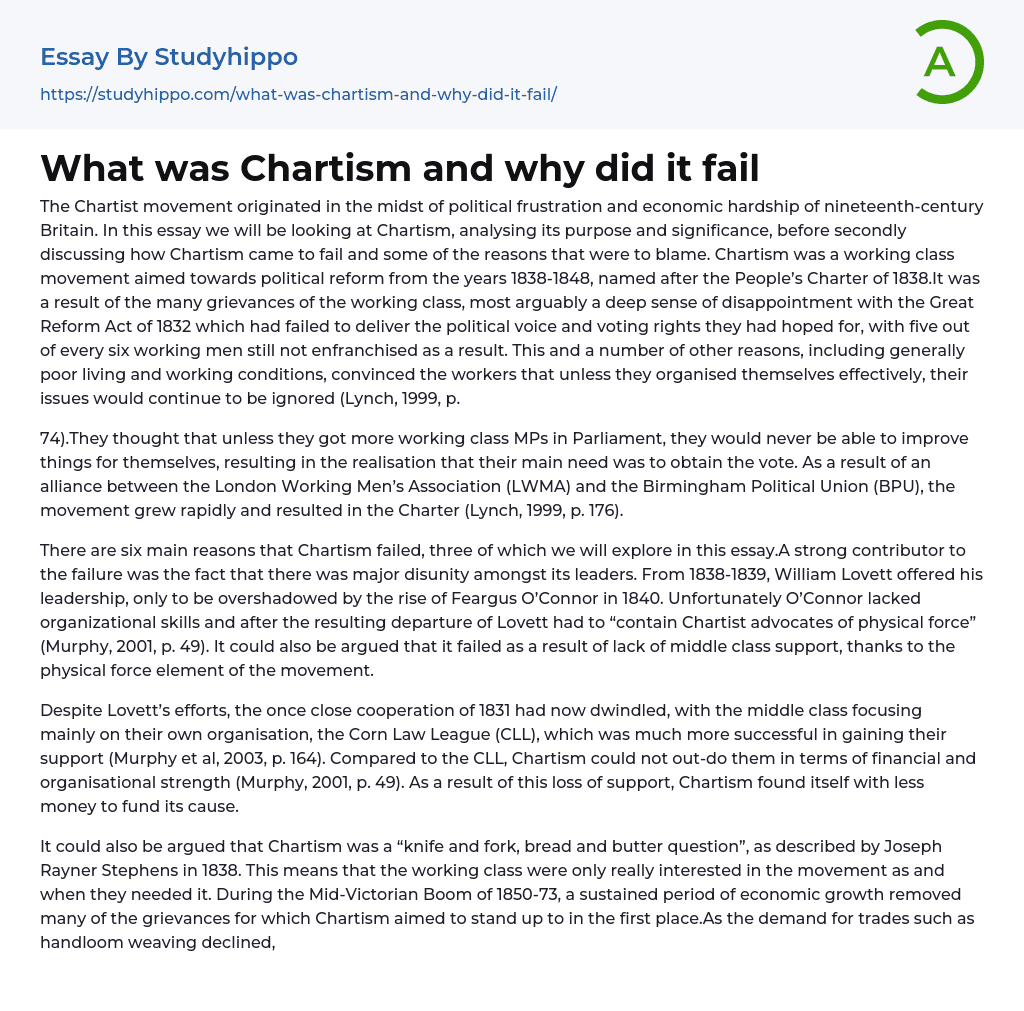The Chartist movement originated in the midst of political frustration and economic hardship of nineteenth-century Britain. In this essay we will be looking at Chartism, analysing its purpose and significance, before secondly discussing how Chartism came to fail and some of the reasons that were to blame. Chartism was a working class movement aimed towards political reform from the years 1838-1848, named after the People’s Charter of 1838.It was a result of the many grievances of the working class, most arguably a deep sense of disappointment with the Great Reform Act of 1832 which had failed to deliver the political voice and voting rights they had hoped for, with five out of every six working men still not enfranchised as a result. This and a number of other reasons, including generally poor living and working conditions, convinced the workers
...that unless they organised themselves effectively, their issues would continue to be ignored (Lynch, 1999, p.
74).They thought that unless they got more working class MPs in Parliament, they would never be able to improve things for themselves, resulting in the realisation that their main need was to obtain the vote. As a result of an alliance between the London Working Men’s Association (LWMA) and the Birmingham Political Union (BPU), the movement grew rapidly and resulted in the Charter (Lynch, 1999, p. 176).
There are six main reasons that Chartism failed, three of which we will explore in this essay.A strong contributor to the failure was the fact that there was major disunity amongst its leaders. From 1838-1839, William Lovett offered his leadership, only to be overshadowed by the rise of Feargus O’Connor in 1840. Unfortunatel
O’Connor lacked organizational skills and after the resulting departure of Lovett had to “contain Chartist advocates of physical force” (Murphy, 2001, p. 49). It could also be argued that it failed as a result of lack of middle class support, thanks to the physical force element of the movement.
Despite Lovett’s efforts, the once close cooperation of 1831 had now dwindled, with the middle class focusing mainly on their own organisation, the Corn Law League (CLL), which was much more successful in gaining their support (Murphy et al, 2003, p. 164). Compared to the CLL, Chartism could not out-do them in terms of financial and organisational strength (Murphy, 2001, p. 49). As a result of this loss of support, Chartism found itself with less money to fund its cause.
It could also be argued that Chartism was a “knife and fork, bread and butter question”, as described by Joseph Rayner Stephens in 1838. This means that the working class were only really interested in the movement as and when they needed it. During the Mid-Victorian Boom of 1850-73, a sustained period of economic growth removed many of the grievances for which Chartism aimed to stand up to in the first place.As the demand for trades such as handloom weaving declined, many new employment opportunities arose (Murphy, 2001, p. 9).
This resulted in a lack of interest in Chartism when it was not needed, however it peaked in times of depression and unemployment. It could be argued that this lack of consistent motivation was partly to blame for Chartism failing to achieve anything. However, there were some positive effects of Chartism. It could be argued that it helped
to raise the political awareness of Britain’s working class, contributing much to their journey into fighting for political representation at the end of the nineteenth century.Throughout the process it educated them on what their rights should be and how to go about changing their conditions for the better. As a result of the negative reaction to much of the physical force, it lead them to use much more peaceful protesting and campaigning techniques to get their point across in the future, which worked out positively for them in the long run.
In conclusion, the idea of Chartism was one that certainly had potential. Had it the correct level of organisation, financial stability and support from more of the public it may have been within reach of accomplishment with positive benefits for the working class. However, despite its failure to obtain any significant results, it did play a part in the gain of a political awareness for the majority of the working class.
- Business Law essays
- Contract essays
- Consumer Protection essays
- Property essays
- Ownership essays
- Agreement essays
- Common Law essays
- Contract Law essays
- Justice essays
- Security essays
- Tort Law essays
- United States Constitution essays
- Crime essays
- Lawsuit essays
- Treaty essays
- Family Law essays
- Marijuana Legalization essays
- Constitution essays
- War on Drugs essays
- Court essays
- Jury essays
- Police essays
- Protection essays
- Community Policing essays
- Criminal Law essays
- Judge essays
- Lawyer essays
- Employment Law essays
- Copyright Infringement essays
- Injustice essays
- Intellectual Property essays
- Breach Of Contract essays
- Jurisprudence essays
- Social Injustice essays
- Juvenile Justice essays
- Internet Privacy essays
- Cyber Security essays
- Bill Of Rights essays
- Civil Liberties essays
- First Amendment To The United States Constitution essays
- Fourth Amendment To The United States Constitution essays
- Second amendment essays
- Animal Cruelty essays
- Law Enforcement essays
- Juvenile Justice System essays
- Surveillance essays
- Forensic Science essays
- Crime Prevention essays
- Criminal Justice essays
- Criminology essays




